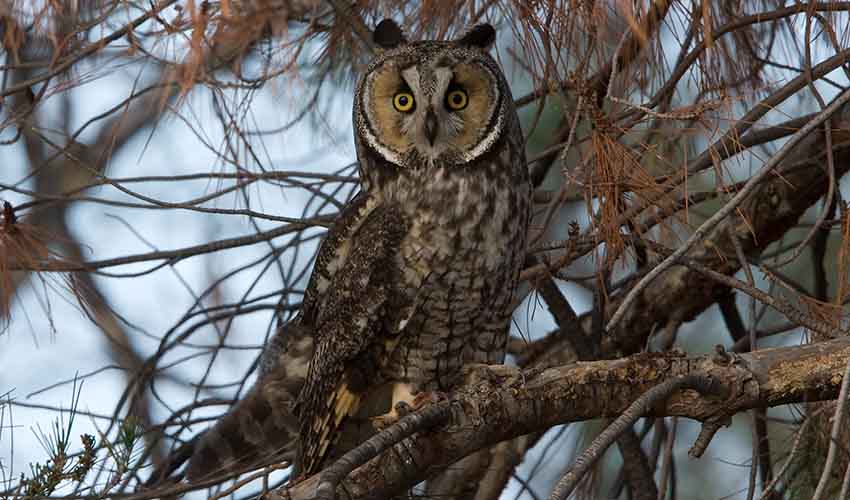Found across Europe, Asia, North America, and parts of North Africa, this adaptable owl thrives in woodlands, farmlands, and open meadows, where trees meet open ground. With its haunting yellow eyes, slender build, and ghostlike flight, the long-eared owl is a quiet presence in the night, perfectly evolved for stealth, precision, and survival in diverse habitats.
At first glance, the long-eared owl’s beauty is strikingly subtle. It has a slender body covered in intricate mottled plumage—a mix of brown, black, buff, and gray that mimics tree bark perfectly. When it perches upright against a branch, it nearly vanishes, a living shadow among leaves and twigs. Its most distinctive features are the elongated ear tufts, which stand tall above its head and give it a look of perpetual alertness. Despite their name, these tufts are not ears at all but movable feathers used for communication and camouflage. When threatened or curious, the owl raises them high; when relaxed, they lie flat. Its true ears are hidden asymmetrically on either side of its skull, giving it superb directional hearing—able to detect the faintest rustle of a mouse beneath leaves or snow.
In flight, the long-eared owl is the embodiment of silent grace. Its wings are long and rounded, allowing for low, buoyant glides as it hunts over fields and grasslands at dusk. Its feathers are uniquely structured to dampen noise: tiny serrations along the edges break up airflow, enabling it to move without a sound. This makes it one of the most efficient and stealthy predators of the night. Its diet consists mostly of small mammals, especially voles, mice, and shrews, though it occasionally takes small birds and insects. After digesting its prey, the owl coughs up pellets—compact bundles of fur and bones—that provide scientists with valuable clues about its diet and habitat.
Distribution
 Afghanistan
Afghanistan Albania
Albania Algeria
Algeria Argentina
Argentina Armenia
Armenia Austria
Austria Azerbaijan
Azerbaijan Bahrain
Bahrain Bangladesh
Bangladesh Belarus
Belarus Belgium
Belgium Belize
Belize Bermuda
Bermuda Bhutan
Bhutan Bolivia
Bolivia Bosnia And Herz.
Bosnia And Herz. Brazil
Brazil British Virgin Is.
British Virgin Is. Brunei
Brunei Bulgaria
Bulgaria Cameroon
Cameroon Canada
Canada Cape Verde
Cape Verde Cayman Islands
Cayman Islands Chad
Chad Chile
Chile China
China Colombia
Colombia Costa Rica
Costa Rica Croatia
Croatia Cuba
Cuba Cyprus
Cyprus Czechia
Czechia Denmark
Denmark Dominican Republic
Dominican Republic Ecuador
Ecuador Egypt
Egypt Eritrea
Eritrea Estonia
Estonia Ethiopia
Ethiopia Falkland Islands
Falkland Islands Faroe Islands
Faroe Islands Finland
Finland France
France French Guiana
French Guiana Georgia
Georgia Germany
Germany Gibraltar
Gibraltar Greece
Greece Greenland
Greenland Guam
Guam Guatemala
Guatemala Guinea
Guinea Guyana
Guyana Haiti
Haiti Hong Kong
Hong Kong Hungary
Hungary Iceland
Iceland India
India Iran
Iran Iraq
Iraq Ireland
Ireland Israel
Israel Italy
Italy Japan
Japan Jordan
Jordan Kazakhstan
Kazakhstan Kenya
Kenya Korea
Korea Kuwait
Kuwait Kyrgyzstan
Kyrgyzstan Laos
Laos Latvia
Latvia Lebanon
Lebanon Liberia
Liberia Libya
Libya Liechtenstein
Liechtenstein Lithuania
Lithuania Luxembourg
Luxembourg Malaysia
Malaysia Maldives
Maldives Mali
Mali Malta
Malta Marshall Islands
Marshall Islands Mauritania
Mauritania Mexico
Mexico Micronesia
Micronesia Moldova
Moldova Mongolia
Mongolia Montenegro
Montenegro Morocco
Morocco Myanmar
Myanmar Nepal
Nepal Netherlands
Netherlands Niger
Niger Nort. Mariana Is.
Nort. Mariana Is. North Korea
North Korea North Macedonia
North Macedonia Norway
Norway Oman
Oman Pakistan
Pakistan Paraguay
Paraguay Peru
Peru Philippines
Philippines Poland
Poland Portugal
Portugal Puerto Rico
Puerto Rico Qatar
Qatar Romania
Romania Russia
Russia Saint Pierre
Saint Pierre Saudi Arabia
Saudi Arabia Senegal
Senegal Serbia
Serbia Singapore
Singapore Slovakia
Slovakia Slovenia
Slovenia South Georgia
South Georgia Spain
Spain Sri Lanka
Sri Lanka Sudan
Sudan Suriname
Suriname Svalbard
Svalbard Sweden
Sweden Switzerland
Switzerland Syria
Syria Taiwan
Taiwan Tajikistan
Tajikistan Thailand
Thailand Trinidad & Tobago
Trinidad & Tobago Tunisia
Tunisia Turkmenistan
Turkmenistan Turkey
Turkey UAE
UAE US Minor Is.
US Minor Is. US Virgin Islands
US Virgin Islands Uganda
Uganda Ukraine
Ukraine United Kingdom
United Kingdom United States
United States Uruguay
Uruguay Uzbekistan
Uzbekistan Venezuela
Venezuela Vietnam
Vietnam Yemen
YemenAnything we've missed?
Help us improve this page by suggesting edits. Glory never dies!
Suggest an editGet to know me
Terrestrial / Aquatic
Altricial / Precocial
Polygamous / Monogamous
Dimorphic (size) / Monomorphic
Active: Diurnal / Nocturnal
Social behavior: Solitary / Pack / Herd
Diet: Carnivore / Herbivore / Omnivore / Piscivorous / Insectivore
Migratory: Yes / No
Domesticated: Yes / No
Dangerous: Yes / No




